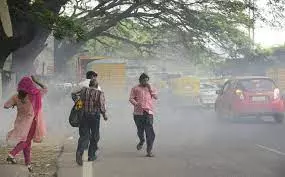Telangana's Air Quality Plan Stagnates Amid Rising Pollution

The board has also not utilised about Rs66crore released under the National Clean Air Programme for the FY 2023-24. In 2023-24, the annual mean concentration of PM 10 has been 81 µg/m³, an improvement from 99 µg/m³ in 2019 and annual mean concentration for PM2.5 was 39.9 µg/m³, from 40 µg/m³ in 2019. While the air quality index has increased over the years, so has the number of vehicles. There were about 1,65,65,130 vehicles in the state as of March 31, 2024.
The state has 14 stations measuring air quality and 30 pollution monitoring devices but all of them in Hyderabad.
Hyderabad, Nalgonda, Sangareddy and Patancheru are non-attainment cities for exceeding the maximum permissible limit of annual mean concentration of PM2.5 in the air specified by World Health Organisation (15 µg/m³) and by the Indian National Ambient Air Quality Standards (40 µg/m³).
“The mean concentration in Hyderabad has always been above those set by WHO,” said Prasad Dasari, nodal officer, National Clean Air Programme. “We have to understand that for Hyderabad, standards have always been high because even during COVID lockdown, the mean concentration of PM2.5 and PM10 were higher than those prescribed by WHO,” he said.
Over the years, the Air Quality Index of the city has been between good and satisfactory, occasionally being reported as poor during winter months. But there have been studies attributing significant health concerns and even deaths to exposure to primary pollutants such as PM2.5 and PM10.
A recent study published in The Lancet Planetary Health, found link between short-term exposure to PM 2.5 and daily mortality and said that even places with less exposure to PM2.5 had high daily mortality. In Hyderabad, according to the study, about 1500 deaths could be attributed to PM2.5 exposure per year. About 5.6% deaths between 2008 and 2019 in Hyderabad are attributable to PM2.5 exposure.
“Concerns for exposure to pollutants need to be taken seriously as increased pollution also weakens the immune system and ability of lungs to fight infectious diseases and smoke damage. Continuous inflammation of long tissue and subsequent oxidative stress due to air pollution is causing a rise in morbidity and mortality. More pollution will lead to more viral infections and respiratory illnesses,” said Dr Vyakarnam Nageshwar, Pulmonogist and clean air activist who led Swachh Akash Abhiyan in Hyderabad.

